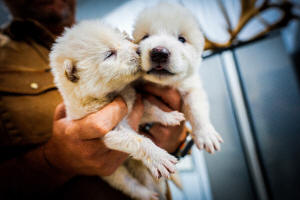Scientists genetically engineer wolves with white hair and muscular jaws
like the extinct dire wolf
[April 08, 2025]
By CHRISTINA LARSON
Three genetically engineered wolves that may resemble extinct dire
wolves are trotting, sleeping and howling in an undisclosed secure
location in the U.S., according to the company that aims to bring back
lost species.
The wolf pups, which range in age from three to six months old, have
long white hair, muscular jaws and already weigh in at around 80 pounds
— on track to reach 140 pounds at maturity, researchers at Colossal
Biosciences reported Monday.
Dire wolves, which went extinct more than 10,000 years old, are much
larger than gray wolves, their closest living relatives today.
Independent scientists said this latest effort doesn't mean dire wolves
are coming back to North American grasslands any time soon.
“All you can do now is make something look superficially like something
else"— not fully revive extinct species, said Vincent Lynch, a biologist
at the University at Buffalo who was not involved in the research.
Colossal scientists learned about specific traits that dire wolves
possessed by examining ancient DNA from fossils. The researchers studied
a 13,000 year-old dire wolf tooth unearthed in Ohio and a 72,000
year-old skull fragment found in Idaho, both part of natural history
museum collections.

Then the scientists took blood cells from a living gray wolf and used
CRISPR to genetically modify them in 20 different sites, said Colossal's
chief scientist Beth Shapiro. They transferred that genetic material to
an egg cell from a domestic dog. When ready, embryos were transferred to
surrogates, also domestic dogs, and 62 days later the genetically
engineered pups were born.
Colossal has previously announced similar projects to genetically alter
cells from living species to create animals resembling extinct woolly
mammoths, dodos and others.
Though the pups may physically resemble young dire wolves, "what they
will probably never learn is the finishing move of how to kill a giant
elk or a big deer," because they won't have opportunities to watch and
learn from wild dire wolf parents, said Colossal's chief animal care
expert Matt James.
[to top of second column]
|

This undated photo provided by Colossal Biosciences shows two pups
that were genetically engineered with similarities to the extinct
dire wolf. (Colossal Biosciences via AP)

Colossal also reported today that it had cloned four red wolves
using blood drawn from wild wolves of the southeastern U.S.'s
critically endangered red wolf population. The aim is to bring more
genetic diversity into the small population of captive red wolves,
which scientists are using to breed and help save the species.
This technology may have broader application for conservation of
other species because it's less invasive than other techniques to
clone animals, said Christopher Preston, a wildlife expert at the
University of Montana who was not involved in the research. But it
still requires a wild wolf to be sedated for a blood draw and that's
no simple feat, he added.
Colossal CEO Ben Lamm said the team met with officials from the U.S.
Interior Department in late March about the project. Interior
Secretary Doug Burgum praised the work on X on Monday as a
“thrilling new era of scientific wonder” even as outside scientists
said there are limitations to restoring the past.
“Whatever ecological function the dire wolf performed before it went
extinct, it can’t perform those functions" on today's existing
landscapes, said Buffalo's Lynch.
___
The Associated Press Health and Science Department receives support
from the Howard Hughes Medical Institute’s Science and Educational
Media Group and the Robert Wood Johnson Foundation. The AP is solely
responsible for all content.
All contents © copyright 2025 Associated Press. All rights reserved
 |